Steady to flush is a practical way to finish your bird dog.
By Dave Carty
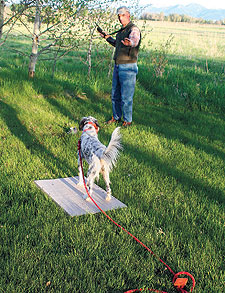 Steadying your gun dog to flush will help ensure the dog's safety. Here, the trainer practices the whoa command with his dog on a whoa board, a check cord snubbed to a stake and an e-collar for additional reinforcement. |
Among we who ponder these issues, the discussions between those who favor training their dogs to be steady to wing, shot and fall and those who prefer to do none of those things are endless, occasionally heated and rarely concluded to anyone's satisfaction.
In camp one, you have the guys who want a finished dog, a dog that won't budge until given the command to do so. Among hunters, the rationale is that a steady dog can better mark falls and won't put up birds down range. I like my dogs as steady as I can get them, but I don't completely buy into any of the reasons I just outlined.
In camp two are the vast majority of bird hunters who have never steadied their dogs, see no reason for doing so, and aren't particularly interested in changing. Many have never hunted over or even seen a dog that is steady to wing and shot. They claim that a dog that breaks at the flush is quicker to the retrieve. I'll give them the benefit of the doubt, but
I'm not completely buying that argument, either.
However, both camps do agree on this: a dog that breaks at the flush can endanger himself if he runs into the path of a shot string.
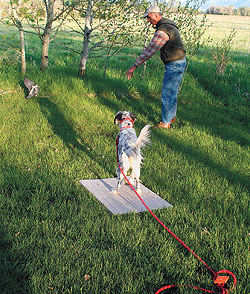 Tossing a clip-wing pigeon is a sure way to tempt the dog to break |
In case that has never happened to you, allow me to explain how it works. We'll use the hypothetical example of a widely experienced bird hunter and dog trainer who happens to write about pointing dogs for a nationally known outdoor magazine. To protect him from the well deserved embarrassment his stupidity caused him, we'll give him an assumed name. Let's see€¦okay, I've got it. We'll call him Dave.
Once upon a time, Dave and a friend were hunting blue grouse. Dave's friend was the man who had hired him to train his English setter that very summer, and this was one of that dog's first hunts. After two hours of fruitless searching, the dog finally stuck a pair of grouse, and Dave walked in for the flush. One bird got up, which Dave killed.
The dog remained steady as trained, and Dave was very proud of the work he'd done. He nodded to his friend, who released his dog, but at that moment, the second bird flushed, which got up directly in front of the now running dog. Dave raised his gun and shot twice -- safely, as it turned out -- but much, much too close to the setter for comfort. Horrified at the mistake he'd made, Dave felt like breaking his extremely pricey side-by-side over his own head.
So. How do you keep your dog safe without going through the considerable time and effort it takes to steady them to wing, shot and fall? The answer is to take the middle way -- steady the dog to flush only. This will still take time and effort, to be sure, but steadying a dog to flush is less work than steadying them all the way through, and much easier to maintain in the field.
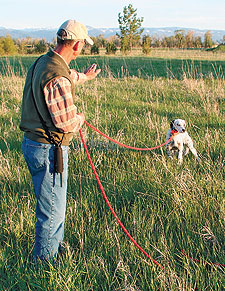 Once the dog is remaining reliably steady to flush in the yard, the transition is made to the field. |
Assuming your dog is already collar conditioned and accustomed to gunfire -- both are a must -- you'll start the process with the "whoa" command, which starts on a bench, a barrel, a table, or whatever else is handy. Put a lead on the dog, set him on the bench, tell him to whoa, then slowly back away. If he moves toward you -- and he will -- pick him up and put him back in place, repeating the command. After you've done this over the course of a few days, you're ready to enforce the command with a collar. At this point, give the whoa command just once, then enforce it with a correction if the dog doesn't obey.
When the dog is obeying your command on the bench, move him to the ground, and have him walk beside you while you grasp the lead. The heel command is helpful here but not necessary. Give him the whoa command and continue walking. Again, if he moves toward you, pick him up and put him back in place, repeating the command.
Once he's grasped that, you're ready to use the collar. As before, you'll now give the command just once, then correct the dog if he moves. If he crouches or slinks toward you, pick him up and put him back in place. Picking a dog up and physically moving him back to where the infraction occurred really seems to get the point across.
Next, you'll move to a whoa board, but if your dog wasn't trained on one, you'll do fine without. You will, however, want to have a stake you can stomp into the ground to tie off your dog. I had a friend weld a roughly three-inch square piece of ¼-inch steel to a 12-inch steel spike, then I spray painted it orange so I wouldn't stomp it into the ground and walk off and leave it, which I've succeeded in training myself to do only two or three times a week.
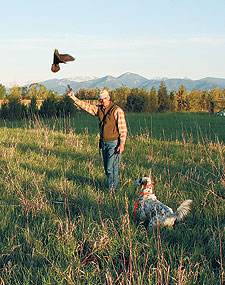 The final step is to fire your pistol a few seconds after the flush and encourage the dog to break. |
Anyway, walk the dog over the board, whoa him, then tie the lead to the stake with very little slack. You want to stop your dog from running, not break his neck. If you haven't got a board, simply whoa him in place.
Now the rubber meets the road. Throw a clipped-wing pigeon in front of him, 10 or 15 feet away. When he lunges for the bird -- and I've never seen one who didn't -- repeat the whoa command, and then pick him up and replace him. You may have to do this several times to get him to remain steady for even a few seconds, but if he does, you're golden. Pack it in and repeat the exercise later or on the following day.
When the dog is remaining steady for 30 seconds to a minute, you're ready for the last stage. Plant a bird in a launcher, turn the dog loose, and let him find and point it. Then whoa him, step on the
lead (don't tie him to a stake), and release the bird. He'll probably chase, but you know the drill -- repeat the whoa command, then pick him up and replace him. When he's grasped that, repeat the same drill with the collar. Don't rush things; this may take several weeks.
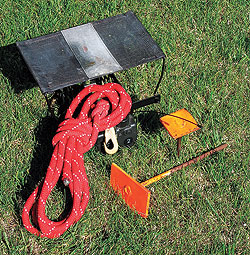 A bird launcher, a strong lead and a couple of snubbing stakes are the equipment you'll need. |
Finally, repeat the same exercise, but this time, fire your cap pistol a few seconds after the flush, remove your foot from the lead, and immediately encourage him to break.
That's all there is to it. Of course, nothing in the field is as simple as people like me make it sound in print. To keep the dog from anticipating the shot, let every third or fourth bird fly away without shooting. If the dog breaks, correct him.
Some days he'll hold, and some days he'll break. Continue correcting him when he breaks at the flush and encouraging him to break at the shot. Believe me, getting him to break at the shot will be a lot easier than getting him to hold through a flush. At some point -- it could happen as quickly as several weeks or as long as several months -- you'll want to take him somewhere and shoot planted pigeons over him. When that time comes, get someone to shoot for you so you can handle the dog; don't even think about trying to do both yourself.
If the dog is up to speed in the yard, it usually won't take long to polish him up in the field. Several dogs I've trained were good to go after I shot just eight or 10 live birds over them. But don't skip this step; and don't try to shortcut the process by doing it on a real hunt. Keeping your dog honest on a real hunt is the very last stage of the process.
That last stage is a good news/bad news deal, however. The good news is that your dog is almost there. If you put down your gun on your first few hunts and devote your attention to handling your dog, with any luck you'll have a dog steady to flush for the rest of his life.
The bad news is that no matter how well you've laid the groundwork, he'll still test you from time to time. Some dogs will test you a little, some a lot, but they all do it. If he reverts to breaking at the flush on a hunt, put down your gun, drag him back to the infraction, and scold him. He'll get the idea. But just to be sure, watch him like a hawk the next time he points.
Without a doubt, steadying a dog to flush takes effort and your dog won't always enjoy the process. But he'll come around if you keep at it, and without the safety issue hanging over your head, you'll find yourself drawn ever deeper into the rhythm of the hunt -- the point, the shot, and a well-trained and safe dog.






